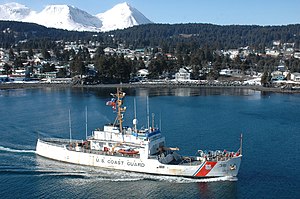USCGC Storis (WMEC-38)

The USCGC Storis (WMEC-38), after decommissioning.
|
|
| History | |
|---|---|
|
|
|
| Name: | USCGC Storis |
| Ordered: | 26 January 1941 |
| Builder: | Toledo Shipbuilding Company, Toledo, Ohio |
| Cost: | $2,072,889 USD (hull & machinery) |
| Laid down: | 14 July 1941 |
| Launched: | 4 April 1942 |
| Commissioned: | 30 September 1942 |
| Decommissioned: | 12 February 2007 |
| Motto: | ALASXAM ILAQAAN MAYAAQISNIIKACHXIIZAX (Great Hunter of Alaskan Waters) |
| Nickname(s): |
|
| Status: | Scrapped |
| General characteristics | |
| Displacement: | 2,030 long tons (2,060 t) |
| Length: | 230 ft (70 m) |
| Beam: | 43 ft 2 in (13.16 m) |
| Draft: | 15 ft (4.6 m) |
| Propulsion: | Diesel-electric |
| Speed: | 14 kn (26 km/h; 16 mph) |
| Range: | 22,000 mi (35,000 km) |
| Complement: | 12 officers; 72 enlisted (2006) |
| Sensors and processing systems: |
SPS-64 I-band navigation search radar |
| Armament: |
|
|
USCGC STORIS (cutter)
|
|
| NRHP Reference # | 12001110 |
| Added to NRHP | December 31, 2012 |
USCGC Storis (WAGL-38/WMEC-38) was a light icebreaker and medium endurance cutter which served in the United States Coast Guard for 64 years and 5 months, making her the oldest vessel in commission with the Coast Guard fleet at the time. She was also the first American vessel to circumnavigate North America.
The ship was laid down by the Toledo Shipbuilding Company of Toledo, Ohio, on 14 July 1941. Storis was launched on 4 April 1942 and commissioned on 30 September 1942 as an ice patrol tender. Initially assigned to the North Atlantic during World War II, Storis participated in the Greenland Patrols. She was tasked with patrolling the east coast of Greenland to prevent the establishment of German weather stations. During her first years, Storis operated in the very waters from which her name was derived. Originally to be named Eskimo, the U.S. Department of State objected to the name of the new cutter on the basis that the natives of Greenland would be offended by the name. "Storis" is a Scandinavian word meaning "great ice."
On 10 June 1943, she began escorting convoy GS-24 from Narsarssuak to St. John's, Newfoundland, in company with the USCGC Mojave (flag), Tampa, Escanaba, and Algonquin, the convoy consisting of USAT Fairfax and USS Raritan. At 0510 on the 13th, dense black and yellow smoke was reported rising from the Escanaba. She sank at 0513. Storis and Raritan were ordered to investigate and rescue survivors while the rest of the convoy began zigzagging and steering evasive courses to avoid submarines. At 0715 the two cutters returned, having rescued 2 survivors and found the body of Lt. Robert H. Prause, which was on the Raritan. No explosion had been heard by the other escort vessels. The entire crew of 103 of the Escanaba was lost with the exception of these two men.
...
Wikipedia
